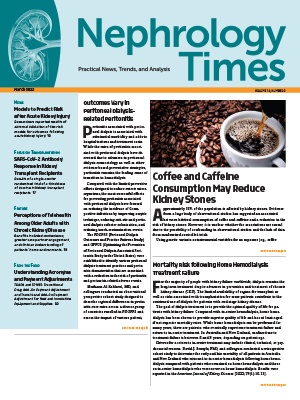
For the majority of people with kidney failure worldwide, dialysis remains the long-term treatment despite advances in prevention and treatment of chronic kidney disease (CKD). The limited availability of organs for transplant as well as risks associated with transplantation for some patients contribute to the continued use of dialysis for patients with end-stage kidney disease.
The goal of dialysis treatment is to provide the optimal quality of life for patients with kidney failure. Compared with in-center hemodialysis, home hemodialysis has been shown to provide superior quality of life and has at least equal if not superior mortality rates. While home hemodialysis can be performed for many years, there are patients who eventually experience treatment failure and return to in-center treatment. In Australia and New Zealand, median time to treatment failure is between 5 and 8 years, depending on patient age.
Drivers for a return to in-center treatment may include clinical, technical, or psychosocial reasons. David J. Semple, PhD, and colleagues conducted a retrospective cohort study to determine the early and late mortality of all patients in Australia and New Zealand who returned to in-center hemodialysis following home hemodialysis compared with patients who remained on home hemodialysis and those on in-center hemodialysis who were never on home hemodialysis. Results were reported in the American Journal of Kidney Diseases [2022;79(1):15-23].
The study cohort included all patients in the Australia and New Zealand Dialysis and Transplant Registry who initiated hemodialysis during 2005-2015 and were treated for >90 days. The outcomes of interest were mortality and cause of death.
The cohort was stratified into four states: state 1, in-center hemodialysis, no home hemodialysis; state 2, first home hemodialysis episode; state 3, in-center hemodialysis, prior home hemodialysis; state 4, home hemodialysis, prior in-center hemodialysis and home hemodialysis. Individual patients moved between states over time but were only ever in one state at a time. Of the 19,158 patients initiating in-center hemodialysis (state 1), only 2309 transitioned to home hemodialysis.
The association between patient treatment states and mortality was examined using a time-varying multivariate Cox proportional hazards analysis with shared frailty. Patients were censored at the time of transplantation or change in treatment modality to peritoneal dialysis.
Of the 23,358 patients who initiated hemodialysis between 2005 and 2015, 19,306 remained alive on hemodialysis for >90 days. Median follow-up time was 2.2 years. At initiation of dialysis, mean age was 60.8 years, 62.1% were male, and nearly 49% had diabetes. Of the total cohort, 87% (n=16,752) never experienced home hemodialysis, and 13% (n=2554) received home hemodialysis during the study period. Of those 2554, 2457 either moved from in-center hemodialysis to home hemodialysis (n=2309) or initiated home hemodialysis directly (n=148). An additional 97 patients transferred to home hemodialysis from transplant or peritoneal dialysis and were not included in the survival analysis.
Compared with the group who never experienced home hemodialysis, those who did were younger, more likely to be male, and more likely to be Maori or Pacific Islander. They were also more likely to have obesity (defend as body mass index >30 kg/m2), more likely to have polycystic kidney disease or reflux as their primary kidney disease, and more frequently had an arteriovenous fistula as their first dialysis access. They were less likely to be a late referral to renal services, have major associated major comorbidities, or have an central catheter as first dialysis access.
Overall, 23.5% (n=577) of home hemodialysis patients transitioned from state 2 to state 3; of those 29.6% (n=171) then restarted home hemodialysis during the study period (state 4). Of the patients entering state 4, 61 subsequently transferred back to in-center home dialysis, when they were censored from the analysis.
During the 2.2 years of follow-up, 6972 patients died. The crude death rate was highest in state 1 (crude rate, 14.9 [95% confidence interval [CI], 14.5-15.2] per 100 patient years) and state 3 (14.4 [95% CI, 12.1-16.8] per 100 patient years) and lowest in state 2 (4.4 [95% CI, 3.9-5.0] per 100 patient years) and state 4 (5.9 [95% CI, 3.6-9.0] per 100 patient-years. During the first 30 days, 30 to 90 days, and >90 days, mortality rates in state 3 were 20.6 (95% CI, 9.9-37.9), 17.5 (95%CI, 9.8-28.8), and 13.6 (95% CI, 11.3-16.3) per 100 patient-years, respectively.
Results of both univariate and multivariate analyses demonstrated that home hemodialysis treatment failure (transition from home hemodialysis to in-center hemodialysis) was associated with an increased risk of death in the first 30 days (hazard ratio [HR], 3.93; 95% CI, 2.09-7.40; P<.001), between 30 and 90 days (HR, 3.34; 95% CI, 1.98-5.62; P<.001), and beyond 90 days (HR, 2.29; 95%cI, 1.84-2.85; P<.001)
Patient age, late referral, smoking status, cause of kidney failure, and the presence of major comorbidities (coronary artery disease, cerebrovascular disease, peripheral vascular disease, chronic lung disease, and diabetes) were also significant independent covariates for death. There were associations between Caucasian ethnicity and the use of an arteriovenous fistula for dialysis access and a reduced risk of death. Only patient age was associated with a similar magnitude of risk for mortality as home hemodialysis treatment failure.
During the study period, the most common causes of death were withdrawal from treatment (n=2500; 4.9 [95% CI, 4.7-5.1] per 100 person-years) and cardiovascular events (n=2246; 4.4 [95% CI, 4.2-4.6] per 100 person-years). Less common causes of death were infection, malignancy, and other causes.
The retrospective design of the study was cited as a limitation to the findings. The researchers also listed the lack of patient-level data on causes or intention of dialysis modality change or medical events before dialysis modality change as study limitations.
In conclusion, the researchers said, “Our study highlights high mortality rates in patients returning to in-center hemodialysis from home hemodialysis, at both early and late time points, and supports the need for further investigation into causes and implications of dialysis modality changes.”
Takeaway Points
- Researchers conducted a retrospective cohort study to assess the early and late mortality of patients utilizing home hemodialysis in Australia and New Zealand who returned to in-center hemodialysis compared with those who stayed on home hemodialysis and those who remained on in-center hemodialysis.
- Following home hemodialysis treatment failure, adjusted mortality was increased compared with continued home hemodialysis.
- The increased risk of mortality was seen in both early (first 30 days and 30-90 days) and late (beyond 90 days) periods after home hemodialysis failure.







 © 2025 Mashup Media, LLC, a Formedics Property. All Rights Reserved.
© 2025 Mashup Media, LLC, a Formedics Property. All Rights Reserved.